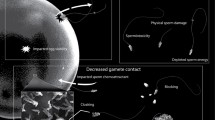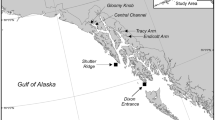Abstract
The dispersion of Acropora coral sperm is critical for sexual reproduction via external fertilization. Sperm sinking likely plays an important role in the process of dispersion, but its rate of sinking is still unclear. To estimate the sinking speed of coral sperm without turbulence, two experiments were conducted in a water tank filled with 500 L of static seawater in the 0–60 cm layer. In Exp. 1, suspension of sperm was gently poured from a 2 L plastic beaker onto the surface of the seawater in the tank. In Exp. 2, sperm were released from egg–sperm bundles from coral colonies at the bottom of the tank. Sinking speeds ranged between 0 and 120 cm h−1. In the sperm sinking experiment (Exp. 1), 43% of sperm remained on the surface layer, while the remainder sank 30–180 min after being poured. Sperm that formed clusters might sink faster. Although the effect of turbulence on the sinking speed of sperm in nature has not yet been clarified, the mean residence time of sperm in the 0–10 cm layer (Exp 2; 0.5–0.7 h) implies that sinking speed inherited in sperm is linked to gamete interactions for fertilization.








Similar content being viewed by others
References
Arai I, Kato M, Heyward A, Ikeda Y, Iizuka T, Maruyama T (1993) Lipid composition of positively buoyant eggs of reef building corals. Coral Reefs 12:71–75
Ayre DJ, Resing JM (1986) Sexual and asexual production of planulae in reef corals. Mar Biol 90:187–190
Babcock RC, Heyward AJ (1986) Larval development of certain gamete-spawning scleractinian corals. Coral Reefs 5:111–116
Babcock RC, Bull GD, Harrison PL, Heyward AJ, Oliver JK, Wallace CC, Willis BL (1986) Synchronous spawnings of 105 scleractinian coral species on the Great Barrier Reef. Mar Biol 90:379–394
Bach LT, Riebesell U, Sett S, Febiri S, Rzepka P, Schulz KZ, Febiri S, Rzepka P, Schulz KG (2012) An approach for particle sinking velocity measurements in the 3–400 μm size range and considerations on the effect of temperature on sinking rates. Mar Biol 159:1853–1864
Bach LT, Boxhammer T, Larsen A, Hildebrandt N, Schulz KG, Riebesell U (2016) Influence of plankton community structure on the sinking velocity of marine aggregates. Glob Biogeochem Cycles 30:1145–1165
Baird AH, Guest JR, Willis BL (2009) Systematic and biogeographical patterns in the reproductive biology of scleractinian corals. Ann Rev Ecol Evol Syst 40:551–571
Berke AP, Turner L, Berg HC, Lauga E (2008) Hydrodynamic attraction of swimming microorganisms by surfaces. Phys Rev Lett 101:038102. https://doi.org/10.1103/PhysRevLett.101.038102
Boryshpolets S, Cosson J, Bondarenko V, Gillies E, Rodina M, Dzyuba B, Linhart O (2013) Different swimming behaviors of sterlet (Acipenser ruthenus) spermatozoa close to solid and free surfaces. Theriogenology 79:81–86
Chang H, Kim BJ, Kim YS, Suarez SS, Wu M (2013) Different migration patterns of sea urchin and mouse sperm revealed by a microfluidic chemotaxis device. PLoS One 8:e60587. https://doi.org/10.1371/journal.pone.0060587
Chui APY, Wong MC, Liu SH, Lee GW, Chan SW, Lau PL, Leung SM, Put A Jr (2014) Gametogeneisis, embryogenesis, and fertilization ecology of Platygyra acuta in marginal nonreefal coral communities in Hong Kong. J Mar Biol. https://doi.org/10.1155/2014/953587
Dunson DB, Weinberg CR, Perreault SD, Chapin RE (1999) Summarizing the motion of self-propelled cells: applications to sperm motility. Biometrics 55:537–543
Durkin CA, Estapa ML, Buesseler KO (2015) Observations of carbon export by small sinking particles in the upper mesopelagic. Mar Chem 175:72–81
Falkenberg LJ, Havenhand JN, Styan CA (2016) Sperm accumulated against surface: a novel alternative bioassay for environmental monitoring. Mar Environ Res 114:51–57
Fisher HB, List EJ, Koh RCY, Imberger J, Brooks NH (1979) Mixing in inland and coastal waters. Academic Press, San Diego, p 302
Geyer WR, Morris JT, Prahl FG, Jay DA (2000) Interaction between physical processes and ecosystem structure: a comparative approach. In: Hobbie JE (ed) Estuarine science: a synthetic approach to research and practice. Island Press, Washington DC, pp 177–206
Harrison PL, Wallace C (1990) Reproduction, dispersal and recruitment of scleractinian corals. In: Dubinsky Z (ed) Coral reefs. Elsevier, Amsterdam, pp 133–207
Hayashibara T, Shimoike K, Kimura T, Hosaka S, Heyward A, Harrison P, Kudo K, Omori M (1993) Patterns of coral spawning at Akajima Island, Okinawa, Japan. Mar Ecol Prog Ser 101:253–262
Hill PS, Nowell ARM, Jumars PA (1992) Encounter rate by turbulent shear of particles similar in diameter to the Kolmogorov scale. J Mar Res 50:643–668
Iguchi A, Morita M, Nakajima Y, Nishikawa A, Miller D (2009) In vitro fertilization efficiency in coral Acropora digitifera. Zygote 17:225–227
Iwao K, Omori M, Taniguchi H, Tamura M (2010) Transplanted Acropora tenuis (Dana) spawned first in their life 4 years after culture from eggs. Glaxea J Coral Reef Stu 11:38
Kapral R (2008) Multiparticle collision dynamics: simulation of complex systems on mesoscales. Adv Chem Phys 140:89–146
Kinzie RA III, Buddemeier RW (1996) Reefs happen. Glob Chang Biol 2:479–494
Knauss JA (2017) Introduction to physical oceanography. Waveland Press Inc, Long Grove, p 310
Levitan DR, Petersen C (1995) Sperm limitation in the sea. Trends Ecol Evol 10:228–231
Matsukawa Y, Suzuki T (1985) Box model analysis of hydrography and behaviour of nitrogen and phosphorus in a eutrophic estuary. J Oceanogr Soc Japan 41:407–426
Meyer T, Schindler H (1988) Particle counting by fluorescence correlation spectroscopy. Biophys J 54:983–993
Monsen NE, Cloern JE, Lucas LV, Monismith SG (2002) A comment on the use of flushing time, residence time, and age as transport time scales. Limnol Oceanogr 47:1545–1553
Morita M, Nishikawa A, Nakajima A, Iguchi A, Sakai A, Takemura A, Okuno M (2006) Eggs regulate sperm flagella motility initiation, chemotaxis and inhibition in the coral Acropora digitifera, A. gemmifera and A. tenuis. J Exp Biol 209:4574–4579
Nakamura R, Ando W, Yamamoto H, Kitano M, Sato A, Nakamura M, Kayanne H, Omori M (2011) Corals mass-cultured from eggs and transplanted as juveniles to their native, remote coral reef. Mar Ecol Prog Ser 436:161–168
Nozawa Y, Isomura N, Fukami H (2015) Influence of sperm dilution and gamete contact time on the fertilization rate of scleractinian corals. Coral Reefs 34:1199–1206
Oliver J, Babcock R (1992) Aspects of the fertilization ecology of broadcast spawning corals: sperm dilution effects and in situ measurements of fertilization. Biol Bull 183:409–417
Omori M, Fukami H, Kobinata H, Hatta M (2001) Significant drop of fertilization of Acropora corals in 1999: an after-effect of heavy coral bleaching? Limnol Oceanogr 46:704–706
Omori M, Iwao K, Tamura M (2008) Growth of transplanted Acropora tenuis 2 years after egg culture. Coral Reefs 27:165
Padilla-Gamiño JL, Weatherby TM, Waller RG, Gates RD (2011) Formation and structural organization of the egg-sperm bundle of the scleractinian coral Montipora capitate. Coral Reefs 30:371–380
Pratchett MS, Baird AH, Marquis CP (2000) Comparative palatability among eggs of mass-spawning corals. In: Proceedings 9th international coral reef symposium, Bali, pp 23–27
Purcell EM (1977) Life at low Reynolds number. Am J Phys 45:3–11
Ricardo GF, Jones RJ, Clode PL, Humanes A, Negri AP (2015) Suspended sediments limit coral sperm availability. Sci Rep 5:18084. https://doi.org/10.1038/srep18084
Richmond RH (1997) Reproduction and recruitment in corals: critical links in the persistence of reefs. In: Birkeland C (ed) Life and death of coral reefs. Chapman and Hall, New York, pp 175–197
Ripple DC, DeRose PC (2018) Primary determination of particle number concentration with light obscuration and dynamic imaging particle counters. J Res Natl Inst Stan 123:123002. https://doi.org/10.6028/jres.123.002
Rothschild L (1963) Non-random distribution of bull spermatozoa in a drop of sperm suspension. Nature 198:1221–1222
Suzuki G, Okada W, Yasutake Y et al (2018) Interspecific differences in the post-settlement survival of Acropora corals under a common garden experiment. Fish Sci 84:849–856
Takeoka H (1984) Fundamental concepts of exchange and transport time scales in a coastal sea. Continent Shelf Res 3:311–326
Wallace CC (1985) Reproduction, recruitment and fragmentation in nine sympatric species of the coral genus Acropora. Mar Biol 88:217–233
Willis HL, Babcock RC, Harrison PL, Wallace CC (1997) Experimental hybridization and breeding incompatibilities within the mating systems of mass spawning reef corals. Coral Reefs 16:S53–S65
Wolstenholme JK (2004) Temporal reproductive isolation and gametic compatibility are evolutionary mechanisms in the Acropora humilis species group (Cnidaria; Scleractinia). Mar Biol 144:567–582
Xia H, Francois N, Punzmann H, Shats M (2014) Taylor particle dispersion during transition to fully developed. Phys Rev Lett 112:104501. https://doi.org/10.1103/PhysRevLett.112.104501
Yund PO (2000) How severe is sperm limitation in natural populations of marine free-spawners? Trends Ecol Evol 15:10–13
Zayasu Y, Nakajima Y, Sakai S, Suzuki G, Satoh N, Shinzato C (2016) Unexpectedly complex gradation of coral population structure in the Nansei Islands, Japan. Ecol Evol 6:5491–5505
Acknowledgements
This work was supported by ordinary research fund from Tokai University for English proofreading by Editage.
Author information
Authors and Affiliations
Corresponding author
Rights and permissions
About this article
Cite this article
Kono, T., Nakamura, R. & Omori, M. Experimental measurements of the sinking speed of sperm of an acroporid coral, Acropora tenuis, in static seawater. J Oceanogr 76, 109–120 (2020). https://doi.org/10.1007/s10872-019-00529-2
Received:
Revised:
Accepted:
Published:
Issue Date:
DOI: https://doi.org/10.1007/s10872-019-00529-2




